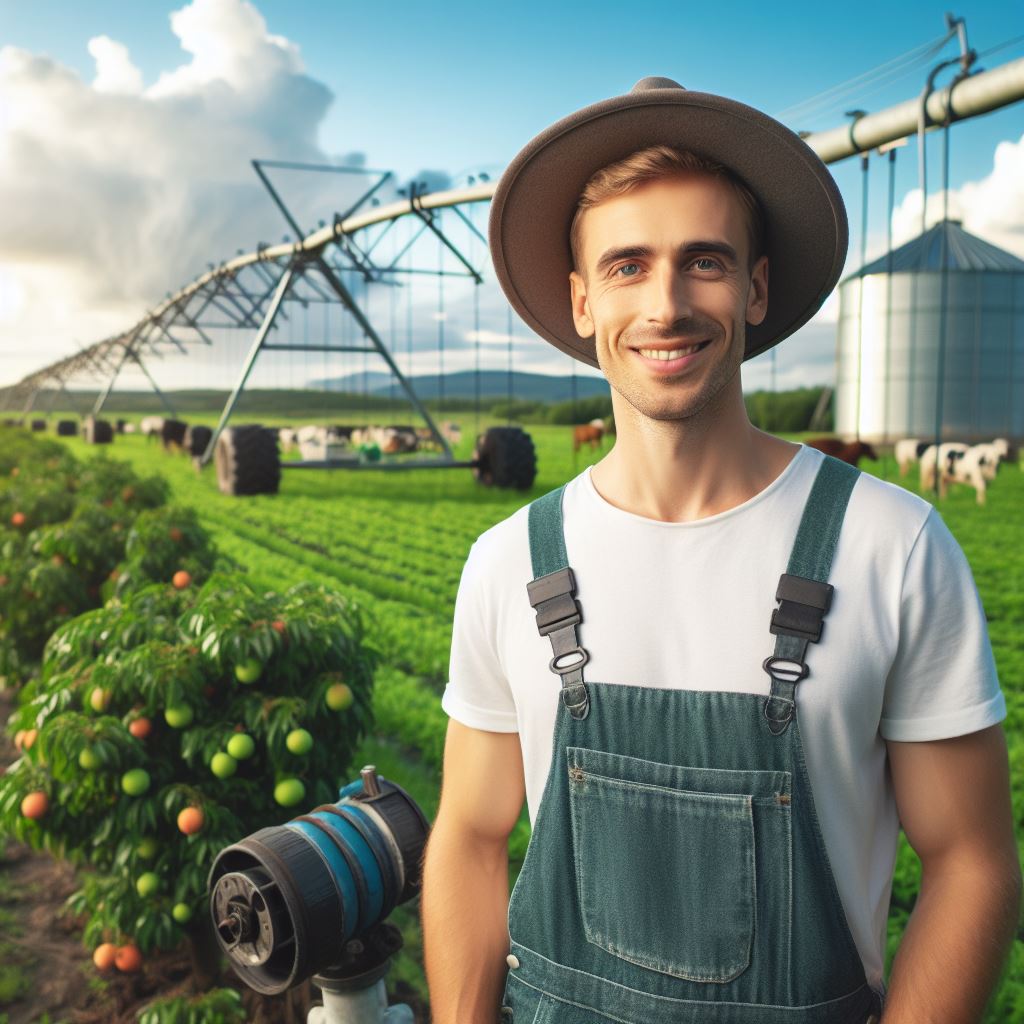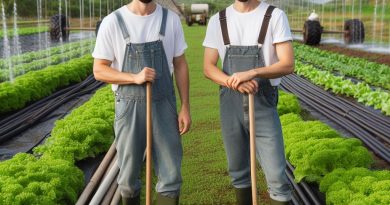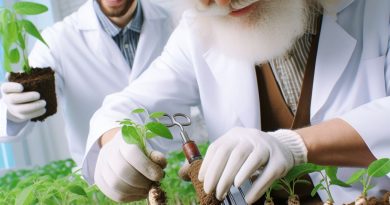Aquaponics in Farming: A Sustainable Water Solution
Last Updated on January 20, 2024
Introduction
Aquaponics is a system that combines aquaculture and hydroponics to achieve sustainable farming.
Addressing water sustainability in farming is crucial to conserve this precious resource.
Aquaponics offers a sustainable water solution for farming, promoting efficiency and ecological balance.
In the dynamic realm of modern agriculture, the quest for sustainable and resource-efficient practices has led to the integration of innovative techniques.
Among these, aquaponics stands out as a compelling solution that harmonizes aquaculture and hydroponics.
This intricate symbiosis not only addresses the burgeoning challenges of water scarcity but also propels farming into a new era of ecological balance.
By seamlessly blending the cultivation of aquatic organisms with soil-less plant growth, aquaponics exemplifies a holistic approach that not only conserves water but also maximizes productivity.
This exploration delves into the multifaceted world of aquaponics, unraveling its principles, benefits, and potential to redefine the landscape of sustainable farming.
The concept of aquaponics
Explanation of how aquaponics works
Aquaponics is a sustainable farming method that combines aquaculture and hydroponics.
It utilizes a symbiotic relationship between fish and plants.
In an aquaponic system, fish are raised in a tank where their waste produces ammonia, which is harmful to fish in high levels.
However, in aquaponics, this ammonia-rich water is filtered and used to provide nutrients for plants.
The plants, in turn, absorb these nutrients and filter out the water, making it safe for the fish.
This cycle creates a constant flow of nutrient-rich water that sustains both the fish and the plants.
Comparison with traditional farming methods
Aquaponics differs significantly from traditional farming methods, mainly due to its closed-loop system.
Unlike traditional farming, which often requires large amounts of water and chemical fertilizers, aquaponics uses less water and relies on organic waste produced by fish.
Traditional farming methods heavily rely on soil quality, weather conditions, and availability of water.
In aquaponics, soil quality is not a concern as plants are grown directly in water with the help of a growing medium such as clay pellets or coconut coir.
This eliminates the need for fertile soil.
Furthermore, aquaponics systems do not require the use of harmful pesticides or chemical fertilizers that can pollute water sources and harm the environment.
The natural balance in an aquaponic system reduces the risk of diseases and pests.
Benefits of aquaponics in terms of water conservation
- Reduced water usage: Aquaponics uses 90% less water compared to traditional farming methods. The water in the system circulates continuously, eliminating the need for excessive irrigation.
- No water pollution: Aquaponics eliminates the risk of water pollution caused by runoff from chemical fertilizers and pesticides. The water is filtered naturally through the plant roots, maintaining its purity.
- Efficient nutrient absorption: The plants in an aquaponic system efficiently absorb nutrients from fish waste. This eliminates the need for synthetic fertilizers, reducing the overall water contamination and conserving resources.
- Drought resistance: Aquaponics is highly drought-resistant due to its closed-loop system. Since water is continuously recycled, it can thrive even in arid climates where traditional farming struggles to survive.
- Sustainable fish production: Aquaponics allows for sustainable fish production due to efficient use of resources. Fish waste acts as a natural fertilizer, reducing reliance on commercial fish food and minimizing overall environmental impact.
In short, aquaponics offers an innovative and sustainable solution to water conservation in farming.
By combining aquaculture and hydroponics, it creates a closed-loop system that significantly reduces water usage and eliminates water pollution.
With its efficient nutrient absorption and drought resistance, aquaponics holds great promise for the future of sustainable farming.
Read: Climate-Smart Agriculture: Water Conservation Tactics
Water efficiency in aquaponics
Reduction of water usage compared to conventional farming
In the world of agriculture, water efficiency is a crucial factor to consider.
Conventional farming methods often require large amounts of water to grow crops, resulting in excessive water consumption.
However, aquaponics offers a sustainable solution by significantly reducing water usage.
Unlike conventional farming, which typically relies on irrigation systems that constantly supply water to the plants, aquaponics utilizes a closed-loop system.
This unique system allows for the recycling and reuse of water, minimizing water wastage. As a result, aquaponics requires only a fraction of the water needed in traditional farming methods.
Utilization of a closed-loop system
Aquaponics operates on a closed-loop system, which is a key aspect of its water efficiency.
The system consists of combining aquaculture and hydroponics, creating a symbiotic relationship between fish and plants that benefits both.
Fish produce waste, which is rich in nutrients. In a conventional farming system, this waste would be seen as a problem, polluting the water and requiring constant cleaning.
However, in aquaponics, this waste becomes a valuable resource.
The fish waste serves as fertilizer for the plants, providing them with essential nutrients to grow.
As the plants absorb these nutrients, they help filter the water and remove harmful substances, purifying it for the fish.
This cycle continues, ensuring that water is continuously cleaned and reused within the system. As a result, aquaponics mitigates the need for excessive water consumption seen in conventional farming methods.
Recycling and reusing water in aquaponics
Water conservation is a fundamental aspect of aquaponics.
The closed-loop system allows for the recycling and reusing of water, contributing to the sustainability of this farming method.
In aquaponics, water is continuously circulated through the system.
The water is initially used to provide nutrients to the plants and accommodate the fish.
As it passes through the plants’ root systems, it absorbs their nutrients before flowing into the fish tank, where the fish live.
Although some water may evaporate or be lost through transpiration, the majority is recaptured, filtered, and reintroduced into the system.
This recycling process helps conserve water, as only minimal amounts are lost over time.
Furthermore, aquaponics systems utilize various techniques to maintain water quality and minimize water loss.
These include the use of biofilters, which efficiently remove solid waste from the water, preventing clogging and ensuring proper circulation.
Additionally, water tests are regularly conducted to monitor pH levels, dissolved oxygen, and other parameters to ensure a healthy environment for both fish and plants.
By maintaining optimal conditions, water can be consistently reused without compromising the well-being of the system’s components.
In fact, aquaponics is a water-efficient farming method known for its ability to reduce water usage and maximize sustainability.
By employing a closed-loop system, aquaponics minimizes water wastage often associated with conventional farming.
The utilization of fish waste as fertilizer and the continuous recycling and reusing of water contribute to the overall efficiency of aquaponics.
As we strive for more sustainable agricultural practices, embracing aquaponics and its water efficiency is a significant step towards a more water-conscious future.
Read: Innovative Farming: Using AI for Water Management
Nutrient management in aquaponics
Aquaponics is a sustainable method of farming that combines aquaculture and hydroponics to create a symbiotic ecosystem.
One of the key elements of successful aquaponics is managing nutrients for optimal plant growth.
Utilization of fish waste for plant nutrients
In aquaponics, fish waste serves as a valuable source of nutrients for plants.
When fish excrete, their waste contains essential elements like nitrogen, phosphorus, and potassium.
These nutrients can be easily absorbed by plants and promote their growth. The waste-rich water is directed to the plant beds, where plants uptake the nutrients they need.
Role of bacteria in converting fish waste
The conversion of fish waste into usable nutrients for plants is facilitated by beneficial bacteria.
Ammonia, a toxic substance in fish waste, is broken down by nitrifying bacteria into nitrites and then further converted into nitrates.
Nitrate is a form of nitrogen that plants can readily absorb and utilize.
These bacteria play a vital role in maintaining a balanced ecosystem within the aquaponics system.
Maintaining a balanced ecosystem for optimal plant growth
To ensure optimal plant growth in aquaponics, maintaining a balanced ecosystem is crucial.
- Monitoring water quality: Regularly testing water parameters such as pH, ammonia, nitrite, and nitrate levels helps to ensure a healthy environment for both fish and plants.
- Controlling fish stocking density: Properly managing the number of fish in the system prevents overcrowding, which can lead to poor water quality and hinder plant growth.
- Adequate aeration: Efficient aeration systems help oxygenate the water, benefiting both fish and the growth of beneficial bacteria that convert fish waste.
- Adding supplemental nutrients: In some cases, additional supplements may need to be added to maintain optimal nutrient levels, especially if the fish waste alone is not sufficient.
- Implementing crop rotation: Regularly rotating crops helps prevent nutrient depletion and promotes balanced nutrient uptake among plants.
By carefully managing these aspects, aquaponic farmers can ensure a thriving ecosystem that provides a continuous supply of nutrient-rich water for plant growth.
Overall, nutrient management is a critical component of successful aquaponic farming.
By utilizing fish waste as a source of nutrients, leveraging beneficial bacteria, and maintaining a balanced ecosystem, aquaponic systems can support optimal plant growth and yield while minimizing environmental impact.
Read: Revolutionizing Agriculture with Greywater Usage
Advantages of Aquaponics for Water Sustainability
Reduction in water pollution from chemical fertilizers
- Aquaponics eliminates the need for synthetic fertilizers, which reduces water pollution.
- Chemical fertilizers often seep into water bodies, causing contamination and harming aquatic life.
- By replacing them with natural fish waste, aquaponics minimizes the release of harmful chemicals.
- This method protects water quality and contributes to the overall sustainability of the ecosystem.
- Aquaponics ensures that water used in farming remains clean and free from harmful pollutants.
- By reducing water pollution, aquaponics protects the biodiversity of surrounding ecosystems.
Prevention of water wastage through excess irrigation
- Traditional farming methods often involve excessive irrigation, leading to water wastage.
- Aquaponics eliminates this issue by using a recirculating water system.
- Water is reused within the system, reducing the need for continuous fresh water supply.
- The water from the fish tank, rich in nutrients, is pumped to the plants, allowing them to grow.
- The excess water not absorbed by plants is filtered and returned to the fish tank, completing the cycle.
- This closed-loop system minimizes water loss and ensures sustainable use of this vital resource.
Preservation of groundwater resources
- Aquaponics relies on a fraction of the water needed in traditional soil-based farming.
- This method does not require digging wells or extensive groundwater extraction.
- By using water efficiently, aquaponics helps preserve precious groundwater resources.
- As groundwater levels continue to decline globally, this sustainable approach is crucial.
- Aquaponics significantly reduces the strain on groundwater supplies, which are already overused in many regions.
- By conserving groundwater, aquaponics helps mitigate the impacts of drought and ensures long-term water availability.
Adopting aquaponics can bring numerous advantages for water sustainability.
Firstly, it reduces water pollution caused by chemical fertilizers. Instead of using synthetic nutrients, this method relies on natural fish waste, minimizing the release of harmful substances into water bodies.
Moreover, aquaponics prevents water wastage through excess irrigation.
By utilizing a closed-loop system, it recirculates water, ensuring its efficient use and eliminating unnecessary water loss.
Finally, aquaponics aids in the preservation of groundwater resources.
As this method requires less water compared to traditional farming, it minimizes the strain on already depleted groundwater supplies.
By embracing aquaponics, we can cultivate food sustainably and secure water resources for future generations.
Read: Water-Wise Farming: Top Crops for Arid Climates

Case studies and success stories
Examples of successful aquaponics farms
- Green Spirit Farms in Michigan: Utilizes aquaponics to grow organic greens, herbs, and fish.
- ECF Farmsystems in Berlin: Successfully combines aquaponics with sustainable food production in urban areas.
- The Plant in Chicago: Operates an aquaponics system that converts waste into valuable resources.
Testimonials from farmers using aquaponics
- John, a farmer in California, shares how aquaponics significantly reduced his reliance on traditional irrigation methods.
- Sarah, a farmer in Australia, praises aquaponics for its ability to produce high-quality crops with minimal water usage.
- Carlos, a farmer in Spain, credits aquaponics for providing a consistent and reliable income throughout the year.
Impacts on crop yield and water usage
- Aquaponics farms have been shown to yield higher crop production compared to traditional farming methods.
- The efficient water circulation and recycling in aquaponics systems result in up to 90% less water usage.
- Studies have indicated that aquaponics can produce up to 8 times more food per unit area compared to soil-based farming.
Overall, these case studies and success stories highlight the potential of aquaponics as a sustainable water solution in farming.
The success of farms like Green Spirit Farms, ECF Farmsystems, and The Plant demonstrates the viability and profitability of aquaponics.
Testimonials from farmers using aquaponics
Furthermore, the testimonials from farmers like John, Sarah, and Carlos emphasize the practical benefits of aquaponics.
They have experienced reduced water usage and improved crop yields, leading to higher profits and greater sustainability in their farming operations.
Not only does aquaponics provide increased crop production, but it also enables farmers to conserve water.
The efficient recycling of water within aquaponics systems significantly reduces the overall water usage. This eco-friendly approach is crucial in regions that experience water scarcity or droughts.
Impacts on crop yield and water usage
The impact on crop yields is also remarkable. Aquaponics has been proven to produce higher yields compared to conventional farming methods.
With proper monitoring and management, aquaponics systems can consistently generate abundant harvests, ensuring food security and reducing the pressure on traditional agriculture.
In general, aquaponics has proven to be a successful and sustainable water solution in farming.
Through case studies, success stories, and testimonials, the benefits of aquaponics in terms of crop yield and water usage are evident.
The success of aquaponics farms and the positive experiences of farmers validate its effectiveness as an innovative and environmentally friendly farming technique.
By embracing aquaponics, farmers can enhance their productivity, profitability, and contribute to a more sustainable agricultural future.
Potential challenges and limitations
Although aquaponics offers numerous benefits, there are several potential challenges and limitations to consider.
These factors can impact the success and sustainability of an aquaponics system.
Initial setup costs and infrastructure requirements
One of the primary challenges is the initial setup costs and infrastructure requirements.
Building an aquaponics system requires a significant financial investment. Materials, equipment, and the construction of fish tanks and grow beds can be expensive.
Additionally, purchasing fish, plants, and the necessary plumbing and filtration systems add to the overall costs.
Learning curve and technical knowledge needed
Another challenge is the learning curve and technical knowledge needed for successful aquaponics farming.
Farmers must acquaint themselves with the intricacies of the system, including the dynamic relationship between fish, plants, and bacteria.
Understanding water chemistry, nutrient cycling, and the biological aspects is crucial for maintaining a healthy and productive system.
Monitoring and controlling water quality
Monitoring and controlling water quality is another potential limitation.
Constant monitoring of water parameters like pH, temperature, and dissolved oxygen is necessary to ensure optimal conditions.
Neglecting water quality can lead to detrimental effects on the fish and plants.
Regular testing and adjustments are crucial to maintaining a balanced ecosystem.
Despite these challenges, aquaponics can be a sustainable water solution in farming.
If farmers are willing to invest in the initial setup costs and familiarize themselves with the technical aspects, they can overcome the learning curve.
By monitoring and controlling water quality, farmers can maintain a thriving aquaponics system.
To address the initial setup costs and infrastructure requirements, farmers can explore options for cost-efficient materials and alternative resources.
Building DIY systems or sourcing used equipment can help reduce expenses.
Additionally, seeking financial assistance or grants available for sustainable farming solutions can support the initial investment.
To overcome the learning curve, farmers can attend workshops, join online communities, or seek mentorship from experienced aquaponic farmers.
Gaining a deeper understanding of the biological aspects and staying updated with advancements in aquaponic farming technology can enhance the chances of success.
Efficient monitoring and controlling systems can be established through technology advancements.
Automated sensors and monitoring devices can help farmers track water quality parameters in real-time, allowing for timely adjustments.
These advancements can streamline the management process and reduce the time and effort required to maintain optimal conditions.
In essence, while aquaponics presents potential challenges and limitations in terms of setup costs, technical knowledge, and water quality management, these hurdles can be overcome.
With proper planning, support, and continuous learning, farmers can harness the benefits of aquaponics and contribute to sustainable water solutions in farming.
Future prospects and expansion
Aquaponics shows immense potential for transforming the future of farming.
With its ability to produce both fish and crops simultaneously, it offers a sustainable water solution for agriculture.
However, the true potential of aquaponics lies in its future prospects and expansion.
Adoption of aquaponics in different farming sectors
Aquaponics is not limited to a single type of farming. It has the potential to revolutionize various farming sectors.
Traditional vegetable farms have already embraced aquaponics to improve productivity while reducing water usage.
The versatility of aquaponics also allows for the cultivation of high-value crops like medicinal herbs and gourmet mushrooms.
Furthermore, large-scale fish farms are exploring the integration of aquaponics systems to better manage waste and optimize resource utilization.
Technological advancements improving efficiency and scalability
Continuous research and development are focused on enhancing the efficiency and scalability of aquaponics systems.
Improved monitoring systems provide real-time data to optimize water quality, nutrient levels, and plant growth.
The development of advanced filtration technologies ensures water purity and fish health.
Automation and remote control capabilities make the management of aquaponics farms easier and more cost-effective.
Additionally, advancements in LED lighting systems enable precise control over the light spectrum, resulting in optimal plant growth.
Potential for integration with renewable energy sources
To further enhance the sustainability of aquaponics, there is a significant potential for integrating renewable energy sources.
Solar panels can power the pumps and filtration systems, reducing reliance on conventional energy sources.
Wind turbines and hydroelectric systems can provide energy for heating or cooling the aquaponics environment.
Additionally, biomass generators can utilize waste from the aquaponics system, creating a closed-loop energy cycle.
Such integration not only reduces the carbon footprint but also lowers the operating costs of aquaponics farms.
In a nutshell, aquaponics has a promising future in farming. Its adoption in various farming sectors provides opportunities for increased food production and resource efficiency.
Technological advancements will continue to improve the efficiency and scalability of aquaponics systems, making them more accessible and cost-effective.
Furthermore, the integration with renewable energy sources will contribute to the sustainability and long-term viability of aquaponics as a water solution for agriculture.
With further research and innovation, aquaponics has the potential to revolutionize the way we farm and provide a sustainable path towards food security.
Conclusion
Aquaponics has proven itself to be a sustainable water solution for farming, addressing the pressing issue of water scarcity.
By recapitulating its benefits, encouraging farmers to explore this innovative method, and reflecting on its potential for the future, it is clear that aquaponics holds great promise in ensuring water sustainability in agriculture.
Aquaponics, with its symbiotic relationship between fish and plants, stands as an eco-friendly system that utilizes water efficiently.
It eliminates the need for excessive water usage, making it a sustainable alternative to traditional farming practices.
As we witness the rapid depletion of water resources, it is imperative for farmers to consider adopting aquaponics.
By implementing this method, they can significantly reduce their water consumption while maximizing their crop yield.
It presents an opportunity for farmers to play a vital role in conserving water and protecting the environment.
The future of aquaponics holds immense potential, with ongoing research and advancements in technology.
It has the capacity to revolutionize the agricultural industry by providing a sustainable approach to food production.
Aquaponics offers an excellent solution to water sustainability in agriculture.
Farmers have the power to make a positive impact by integrating this method into their farming practices.
By embracing aquaponics and reducing water consumption, we can create a more resilient and sustainable future for our food production systems.


